AUCTORES
Globalize your Research
Research Article | DOI: https://doi.org/10.31579/2693-7247/105
1 Debre Markos University, College of Natural and Computational Sciences, Department of Chemistry, Ethiopia.
2 Injibara University, College of Natural and Computational Sciences, Department of Chemistry, Ethiopia.
*Corresponding Author: M. A Omoirri, Department of Pharmacology and Toxicology, Faculty of Pharmaceutical Sciences, Federal University of Oye-Ekiti, Ekiti State, Nigeria.
Citation: Omoirri Moses Aziakpono, Augustine Wisdom Ehimen, Frank Okezie Eze, Maduka Kate Ifeanyi and Osagie Mike Odigie, (2022), Evaluation of the Anti-inflammatory Activity of the Leaf Extract and Fractions of ipomoea Quamoclit in Albino Wistar Rats. J. Pharmaceutics and Pharmacology Research, 5(9); DOI:10.31579/2693-7247/105
Copyright: © 2022 M. A Omoirri, This is an open access article distributed under the Creative Commons Attribution License, which permits unrestricted use, distribution, and reproduction in any medium, provided the original work is properly cited.
Received: 19 September 2022 | Accepted: 21 October 2022 | Published: 17 November 2022
Keywords: ipomoea quamoclit; inflammation; phytochemicals; fractions
Background: Medicinal plants have been shown to contain intrinsic active ingredients that can be used for curative purpose for some diseases. Ipomoea quamoclit is one of such ethnomedicinal plants of reported health benefits.
Aim of study: This study was aimed at evaluating the anti-inflammatory activity of ethanol extract and fractions of the leaves of Ipomoea quamoclit Mill.
Objectives of the study: These include: crude extraction and fractionation of Ipomoea quamoclit leaves; evaluation of the anti-inflammatory and anti-arthritic properties of leaf extract and fractions of Ipomoea quamoclit. Materials and Methods: Ipomoea quamoclit leaves were harvested and extracted with 80% ethanol by cold maceration for 48 hours and the crude extract was fractionated to obtain n-hexane, n-butanol and ethyl acetate fraction, respectively. The crude extract and its fractions were screened to unveil the resident phytochemical constituents. The ethanol extract was tested for acute toxicity (LD50). The systemic acute inflammation of the crude extract and fractions of Ipomoea quamoclit was studied using the water (fluid) displacement method after inducing inflammation with egg albumin, using rats. The effect of the crude extract and fractions of Ipomoea quamoclit on arthritis was studied using the formaldehyde-induced arthritis model in rats.
Results and Conclusions: The results of the qualitative phytochemical evaluation of the plant confirmed the presence of these phytoconstituents such as alkaloids, flavonoids, saponins, tannins, steroids, terpenoids, glycosides, carbohydrates, proteins, and coumarins. There were no deaths recorded for acute toxicity study for both phases of the test. In the acute anti-inflammation assay, significant (P<0.05) anti-inflammatory activities were observed from the 5th hour for the ethyl acetate fraction (150 and 400 mg/kg) and the butanol fraction (400 mg/kg). The anti-arthritic activity of the crude extract (150 mg/kg), ethyl acetate fraction (150 and 400 mg/kg), n-hexane fraction (150 mg/kg) and butanol fraction (150 and 400 mg/kg) was obvious from the second day after administration. By the 10th day the crude extract (50, 150, and 400 mg/kg) and ethyl acetate fraction (150 and 400 mg/kg) brought about a significant reduction of chronic inflammation (arthritis) in the test animals to normal basal levels. This study thus provides scientific information and validates the ethnobotanical use of Ipomoea quamoclit leaves in management of diseases and inflammation inclusive. The findings of this study also reveal that potentially Ipomoea quamoclit could be a source of pharmacologically active compounds of pharmaceutical importance.
Globally, plants which constitute a major component of foodstuffs are sources of therapeutic agents for cure and prevention of diseases. At present more than 35,000 plants species are used for medicinal purposes globally (Yirga et al., 2011).
Plants and plant products have long been used in traditional medicine to treat infectious diseases. The use of medicinal plants remains significant as therapeutic remedies and still plays an important role in primary health care in developing countries such as Nigeria (Onyebule et al., 2014).
For many years’ people depended solely on leaves, flowers and barks of plants for medicine. However, in recent times synthetic drugs which are either replicas or modifications of chemicals identified in plant are being used. (Conway, 1973).
Investigations into the chemical and biological activities of plants during the past two decades have yielded compounds for the development of modern synthetic organic chemistry as a major route for the discovery of novel and more effective therapeutic agents (Roja and Rao, 2002).
Several medicinal plants products are used in Africa for the management of pain and inflammatory conditions with traditional affirmation of their efficacy and potency (Umar et al., 2013). Phytochemicals with various bioactivities including antioxidant, anti-inflammatory and chemotherapeutic properties are extensively extracted from many plant species (Khalita et al., 2013).
In conventional Western medicine, 50-60% of pharmaceutical commodities contain natural products or their derivatives (Cameron et al.,2005). There is a growing interest in correlating phytochemical constituents of plants with their pharmacological activity (Vukovic et al.,2007). Flavonoids have been reported to possess antibacterial activity just as purified alkaloids and their synthetic products are used for various biological effects including antispasmodics, analgesics and antibacterial remedies (Evans, 2002).
Ipomoea quamoclit L. is a less studied medicinal plant, which is an annual, herbaceous; twining vine belongs to the family Convolvulaceae. It is commonly known as cypress vine, star glory, cardinal vine, cardinal creeper, Indian pink, hummingbird vine and cupid’s flower (Chetty et al. 2008, Haque and Ghosh 2013). Ipomoea quamoclit is one of the most commonly seen plant throughout the tropics in and around of the living area from northern South America to Mexico. In India, it is called mayil manikkam, akasamulla, kunjalata, tarulata, kamalata, getphul etc. Plant annual or perennial herb, twining vine which grows upto a height of 1–3 m. Leaves are long (2-9 cm), pinnately lobed, each side of the leaf containing 9-19 lobes. The flowers are long (3-4 cm) with a diameter of 2 cm, five points trumpet-shaped, and can be red, pink or white. It flowers in summer and fall (Lowell and Lucansky 1990).
Ipomoea quamoclit is used as folk medicine around the world for various illnesses (Rajendran et al. 2007, Sajem et al. 2008). The plant is considered cooling and purgative; used in chest pain. Pounded leaves are used as remedy for bleeding piles and carbuncles (Pullaiah et al. 1997, Yusuf et al. 2009). Leaves are also used as poultices for bleeding haemorrhoids (Kumar & Akhtar 2013, Sorathia 2014). Plant found its significant use in Siddha medicine where the decoction of leaves and stems are used to treat fever, diabetes and in Thailand, it is used for snake bites and bloody cough (Khare 2007, Hasan et al. 2009).
Aim of study
This study evaluates the anti-inflammatory properties of ethanol extract and fractions of the leaves of Ipomoea quamoclit. Specifically, study;
Test Animals
Healthy adult Albino Wistar rats of either sex weighing between 200 - 250 g were used for the experiments. The animals were obtained from the animal house of Department of Pharmacology and Toxicology, Faculty of Pharmaceutical Sciences, Nnamdi Azikiwe University, Awka, Anambra State, Nigeria. They were maintained under standard environmental conditions with free access to standard diet and water ad libitum. All animal experiments were conducted in compliance with NIH Guide for Care and Use of Laboratory Animals (Pub. No. 85-23 Revised 1985).
Sample Collection, Identification and Preparation
Fresh leaves of Avocado Ipomoea quamoclit were collected from Awka in the month of October, 2018. The identity of the plant was authenticated by a plant expert at the Department of Pharmacognosy and Traditional Medicine, Nnamdi Azikiwe University, Awka, Anambra State, Nigeria and a voucher specimen deposited (N.a.u.h.n-183a). The leaves were air dried, and the dried leaves were then pulverized to fine powder.
Extraction of Persea americana
i. Crude Extraction
Extraction of the plant leaves was carried out as described by Onyegbule et al. (2014). The pulverized leaves were cold-macerated in ethanol 48 h and filtered. The filtrates were concentrated in a rotary evaporator at 40oC.
ii. Fractionation
Fractionation of the crude ethanol leaf extracts of the plant was carried out as described by Onyegbule et al. (2014). The extracts were fractionated using the liquid-liquid fractionation method with ethyl acetate, n-hexane, and n-butanol. The filtrates obtained were concentrated in a rotary evaporator at 40oC.
Determination of Percentage Yield
The percentage yield for the leaf and seed extract and fractions was calculated and recorded.
Percentage (%) yield= Weight (g) of concentrated leaf or stem extract X 100
Weight (g) of powder leaves or stem 1
Qualitative Phytochemical Analysis
Screening for presence of secondary metabolites (flavonoids, alkaloids, reducing sugars, tannins and saponins, etc. in Ipomoea quamoclit leaves was performed following standard phytochemical tests. The test was carried out according to the procedures outlined by Trease and Evans (2002). Ten percent (10%) preparation of the extract in distilled water was considered as the test samples. Distilled water was used as a negative control throughout the phytochemical tests.
Determination of LD50
The acute toxicity (LD50) of the extract was determined in order to define the range of the lethal dose and the safe range for the extract. The test was carried out in two phases as described by Lorke (1983) using a total of 13 rat of weight 200-250g. In the first phase, the animals were divided into 3 groups of 3 rats each, and the extract was administered at three dose level (10, 100 and 1000 mg/kg) body weight. The animals were then monitored for 24 hours. Based on the results obtained from this first phase, the remaining animals were then grouped into 4 groups of 1 animal each for second phase of the test. In the second phase, 4 dose range were also used 800, 1600, 2900 and 5000 mg/kg body weight. Each dose was administered to one specific group only and the animals were examined again for another 24 hours.
Study Design
Acute inflammatory test
A total of 55 rats were used. They were grouped into 11 groups of five rats per group as follows;
Group 1 received 10ml/kg of distilled water
Group 2 received 50mg/kg of diclofenac
Group 3 received 50mg/kg of crude extract
Group 4 received 150mg/kg of crude extract
Group 5 received 400mg/kg of crude extract
Group 6 received 150mg/kg of ethyl acetate fraction
Group 7 received 400mg/kg of ethyl acetate fraction
Group 8 received 150mg/kg of n-hexane fraction
Group 9 received 400mg/kg of n-hexane fraction
Group 10 received 150mg/kg of butanol fraction
Group 11 received 400mg/kg of butanol fraction
One (1) hour post-treatment, the animals received sub-plantar injection of 0.1 ml of fresh egg albumin in the right hind paw. The paw size was measured before (basal) and at 1, 2, 3, 4 and 5 hour(s) after egg albumin injection.
Chronic inflammation (arthritis) study
The effect of the crude extract and fractions of Ipomoea quamoclit on arthritis was studied using the formaldehyde-induced arthritis model in rats as described by (Udegbunam et al., 2014). A total of 55 rats were used. They were grouped into 11 groups of 5 rats per group.
Group 1 received 10ml/kg of distilled water
Group 2 received 50mg/kg of diclofenac
Group 3 received 50mg/kg of crude extract
Group 4 received 150mg/kg of crude extract
Group 5 received 400mg/kg of crude extract
Group 6 received 150mg/kg of ethyl acetate fraction
Group 7 received 400mg/kg of ethyl acetate fraction
Group 8 received 150mg/kg of n-hexane fraction
Group 9 received 400mg/kg of n-hexane fraction
Group 10 received 150mg/kg of butanol fraction
Group 11 received 400mg/kg of butanol fraction
One (1) hour after administration, the animals received sub-plantar injection of 0.1ml of 2.5% (v/v) formaldehyde in the right hind paw on day zero. The paw volume was measured before (basal) and once every day for 10 days. On day 3, the paw was re-inflamed with formaldehyde. The extract was administered once daily for the 10 days. The volume of water displaced by the inflamed paw was used as measure of edema. Increase in paw volume is quantified as inflammation. Percentage inhibition of edema was calculated using the formula
100 * [1-(a-x/b-y)]
Where a = mean paw volume of treated rat at various times after formaldehyde injection
x = mean paw volume of treated rats before formaldehyde injection
b = mean paw volume of control rats at various times after formaldehyde injection
y = mean paw volume of control rats before formaldehyde injection.
Statistical Analysis
Data obtained from the study were analyzed using Statistical Package for Social Sciences (SPSS-21). Results was expressed as mean ± SEM. Raw data were subjected to one way analyses of variances (ANOVA) followed by post hoc Tukey’s test. P< 0>
Determination of percentage yield
The crude ethanol extract of Ipomoea quamoclit derived from the cold maceration of the powdered dried plant material was fractionated into ethyl acetate, n-hexane, and butanol fractions. The yield from the extraction and fractionation of Ipomoea quamoclit is shown in Table 1.
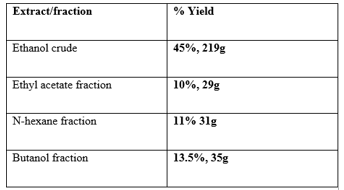
Table 1: Percentage Yield of the crude extract and fractions of Ipomoea quamoclit Leaves
Acute toxicity (LD50) of Ipomoea quamoclit
The LD50 of the extract was above 5000mg/kg as no death was recorded at the highest dose after 24hours monitoring. There was no sign of weakness, anorexia or restlessness observed within 24 hours monitoring.
Qualitative phytochemical analysis of Ipomoea quamoclit leaves
Qualitative phytochemical analysis of Ipomoea quamoclit leaves was conducted using standard methods. It can be observed from the table, that alkaloids, flavonoids, saponins, tannins, steroids, terpenoids, glycosides, carbohydrates, proteins, and coumarins were detected in the plant leaves; while carotenoids and anthraquinones were absent (Table 2).
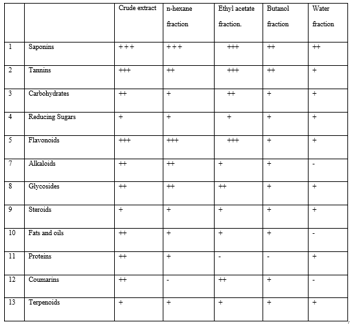
(-) => Not Present, (+) => Present in small concentration, (++) => Present in moderately high concentration, (+++) => Present in high concentration
Table 2: Phytochemical Analysis
Acute-inflammation
The systemic acute inflammation of the crude extract and fractions of Ipomoea quamoclit was studied using the water (fluid) displacement method.
The plant extract and fractions showed varying levels of anti-inflammatory activity and results are presented in Figure 1. Significant (P<0>
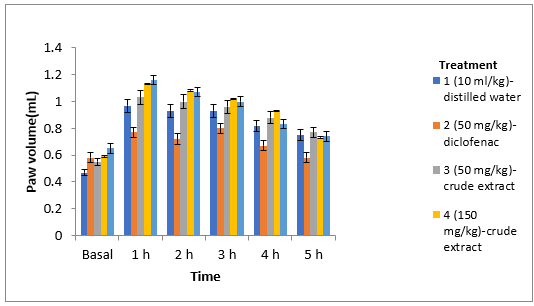
Figure 1: Effect of crude extract of Ipomoea quamoclit Leaves on fresh egg albumin induced paw oedema

Figure 2: Effect of Formaldehyde-induced paw oedema of fractions extract of Ipomoea quamoclit Leaves
Chronic inflammation (arthritis) assay
The effect of the crude extract and fractions of Ipomoea quamoclit on arthritis was studied using the Formaldehyde-induced arthritis model in rats.
The plant extract and fractions showed varying levels of anti-arthritic activity and results of the anti-arthritis assay are presented in Figure 2.
Anti-arthritic activity of the crude extract (150 mg/kg), ethyl acetate fraction (150 and 400 mg/kg), n-hexane fraction (150 mg/kg) and butanol fraction (150 and 400 mg/kg) was obvious from the second day after administration.
By the 10th day the crude extract (50, 150, and 400 mg/kg) and ethyl acetate fraction (150 and 400 mg/kg), just like the standard drug- diclofenac (50 mg/kg), brought about a significant (P<0>
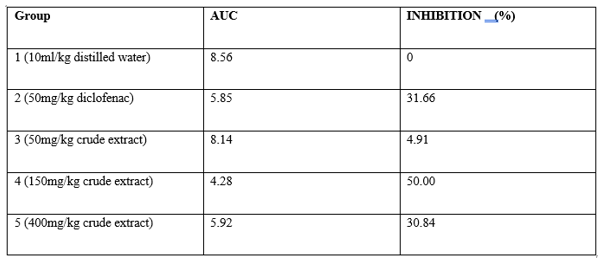
Table 3: AUC of ac inflammation of crude extract of P. americana leaves
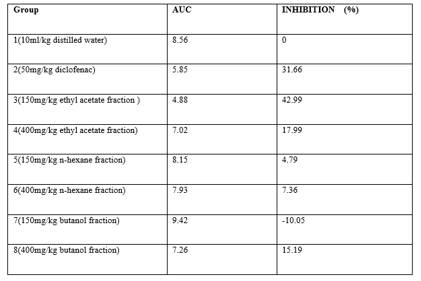
Table 4: AUC of chronic inflammation of fraction of P. americana leaves
Inflammation is a protective response purposely to get rid of organism that causes injury (e.g. microbes and toxins) and the consequence of the injury (e.g. the damage of cell and tissue). Without inflammation, infection will continue developing, wounds will not heal, and the injured organ will continue suppurating. In the process of inflammation, there is a process in which free radical compounds are generated (Ardhie, 2011). Free radicals can cause tissue decay that triggers biosynthesis of arachidonic acid into prostaglandin as the mediator of inflammation (Sanchez et al., 2015). Excessive inflammatory responses or severe tissue decay should be handled immediately, thus inflammatory reaction should be treated to reduce signs and symptoms (Meliala and Pinzon, 2007). General symptoms of inflammation such as swelling, heat, pain, redness, and the loss of function can cause discomfort for the patient so that it needs to be handled (Kristanti et al., 2017). In that case, anti-inflammatory and analgesic compounds are needed.
Ipomoea quamoclit is used in traditional medicine practice with validated claims. The leaves of Ipomoea quamoclit have been used as anticancer (Renuka and Ravishankar 2014), antioxidant (Hasan et al., 2009), antimicrobial (Moin et al., 2012), antidiabetic (Reddy et al., 2015) and Insecticidal Activity (Prodhan et al., 2012)
In this study, the crude extract and fractions of Ipomoea quamoclit showed varying levels of anti-inflammatory activity. This finding are similar to that of (Nworu and Akah 2015), using the plant extract of cyclotide-rich in a similar mode.
These findings are consistent with those of previous studies (Adeyemi et al, 2003) despite differences in experimental design, extraction protocol, solvent, solvent strengths, experimental animals (species, weight, age, gender), animal models, reference standards, sources of plants and time of collection. The anti-inflammatory activities of Ipomoea quamoclit may be attributed to the presence of secondary metabolites and pharmacologically active compounds such as saponins, tannins, flavonoids, fatty acids, steroids, alkaloids. Available reports indicate the biological activities of saponins from medicinal plants are linked to their amphiphilic nature, exhibiting the activities via their capabilities to intercalate into the plasma membrane culminating in changes in membrane fluidity that in turn affect membrane function, thus bringing about cellular response (Hassan et al., 2015). The mechanism for the anti-inflammatory activities of Ipomoea quamoclit may be due to their inhibition of arachidonic acid metabolism, pro-inflammatory cytokines, inducible nitric oxide, transcription activation (NF-eB) (Nworu and Akah, 2015). The varying anti-inflammatory activities may be due on type of formulation (crude extract or fraction), polarity (polar or nonpolar), dose, phytochemical content, binding affinities, physicochemical properties and bioavailability of formulations (Antia et al, 2015). The study found biphasic increases in anti-arthritic activities associated with the crude extract and some fractions but the biphasic increases and decreases differed based on time, formulation, treatment, (extract or fraction) and dose. The present study found that the anti-arthritic activity was a multiphasic phenomenin fluctuating, waxing and waning over time. The anti-arthritic activities were characterized by a first increase followed by first slump, then second increase and second slump or decrease in ant-inflammatory activity. The study confirmed the characteristic Day 2-5 increase in anti-inflammatory activities found in previous studies (Adeyemi et al., 2012). In contrast this present study reported a second slump that occurred on Days 2 and 6-7 not reported by previous studies due to the limited observation period (Kamau et al, 2016) (4 hours). The first increase may be attributed to the release of histamine, serotonin, mast cells, basophils, neutrophils and cyclooxygenase and arachidonic acid metabolism while the first slump may be due to the metabolism of inflammatory cells and mediators. Also, the second increase in anti-inflammatory activities may be due to the secretion of pro-inflammatory mediators such as prostaglandin PGE2, cytokines, interleukins and interferons while the second slump (percentage inhibition) may be due to the binding of inflammatory mediators to their respective receptors, redistribution to systemic circulation, metabolism of pro-inflammatory mediators or down-regulation of bound receptors.
Pharmacologically active substances (phytochemical composition, concentration of bioactive agents with anti-arthritic and anti-inflammatory properties) may have to be released from the formulation (bioavailability) which possess the ability to penetrate the cell membrane (physicochemical properties, concentration, dose, lipid: water partition coefficient) in sufficient concentration over time to achieve and sustain a maximum effect. The time to reach the maximum anti-arthritic activity may depend on the fraction, phytochemical composition, AUC, dose, concentration, physicochemical properties, bio availabilities of pharmacological active and anti-arthritic compounds.
In this study, the ethanol leaf extract and fractions of Ipomoea quamoclit was evaluated for anti-inflammatory. The crude extract and fractions of the Ipomoea quamoclit leaves displayed various degrees of anti-inflammatory, which confirms and validates the ethnobotanical use of the plant leaves in disease management; and also reveal the potentials of Ipomoea quamoclit as a source of pharmacologically active compounds of pharmaceutical importance.